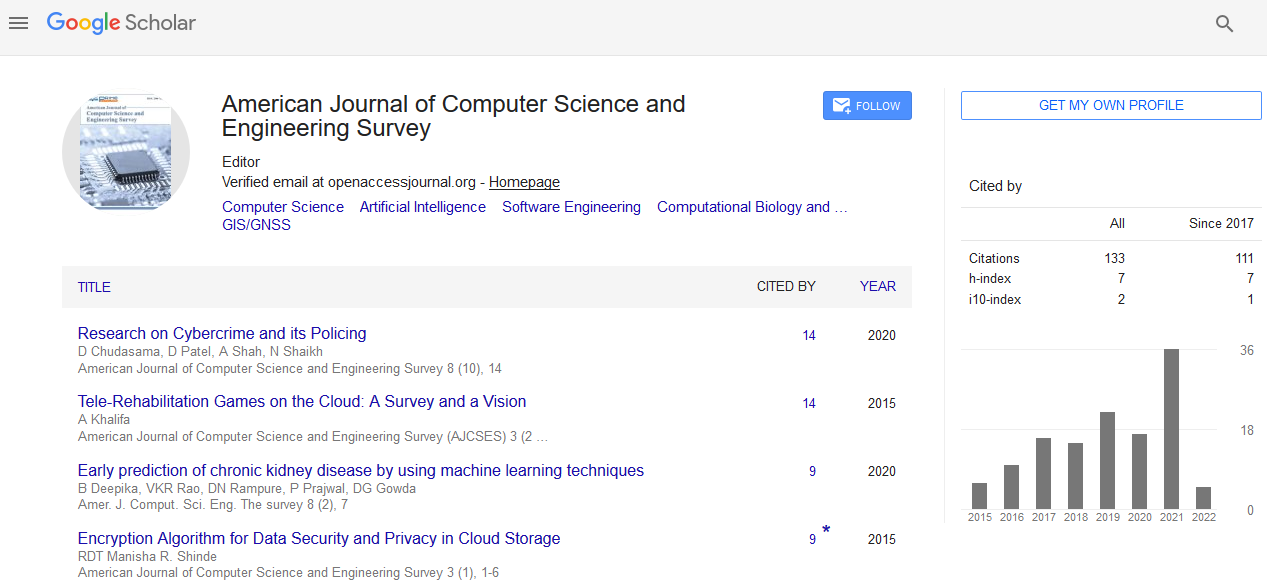Commentary - (2024) Volume 12, Issue 1
Understanding and Utilizing Arrays in Computer Programming
Jameson Colton*
Department of Computer Science and Engineering, BIMM University, UK
*Correspondence:
Jameson Colton,
Department of Computer Science and Engineering, BIMM University,
UK,
Email:
Received: 28-Feb-2024, Manuscript No. IPACSES-24-19981;
Editor assigned: 01-Mar-2024, Pre QC No. IPACSES-24-19981 (PQ);
Reviewed: 15-Mar-2024, QC No. IPACSES-24-19981;
Revised: 20-Mar-2024, Manuscript No. IPACSES-24-19981 (R);
Published:
27-Mar-2024, DOI: 10.36846/2349-7238.24.12.04
Description
Arrays are fundamental data structures in computer
programming, serving as efficient tools for organizing and
manipulating collections of elements. This paper provides
an in-depth exploration of arrays, covering their definition,
types, operations, and applications in various programming
languages. It discusses the advantages and limitations of
arrays, common operations performed on arrays, and best
practices for utilizing arrays effectively in programming.
Additionally, it highlights real-world examples and use cases
to illustrate the versatility and importance of arrays in modern
software development. Arrays play a crucial role in computer
programming by providing a systematic way to store and access
multiple elements of the same data type. Whether handling
a list of numbers, strings, or complex objects, arrays offer a
convenient means to manage and manipulate data efficiently.
This paper aims to elucidate the concept of arrays, elucidating
their significance and practical applications across different
programming paradigms. An array is a contiguous collection of
elements, each identified by at least one index or key. Arrays
can be classified into various types based on their dimensions
and organization: One-dimensional arrays: Elements are
arranged in a single row or column. Multi-dimensional arrays:
Elements are organized in multiple dimensions, such as rows
and columns in a two-dimensional array or layers in a threedimensional
array. Jagged arrays: Arrays of arrays, where
each element can be an array of different lengths. Arrays
support a variety of operations for accessing, modifying, and
manipulating their elements. Common operations include:
Accessing elements: Retrieving individual elements by their
index. Modifying elements: Updating the value of specific
elements. Traversing: Iterating through all elements of the array.
Searching: Finding the index or value of a particular element.
Sorting: Arranging elements in a specified order. Insertion
and deletion: Adding or removing elements from the array.
Arrays offer several advantages, including: Efficient storage
and retrieval of elements. Constant-time access to elements
using indices. Support for various operations and algorithms.
Simplified syntax and ease of use in many programming
languages. However, arrays also have limitations, such as: Fixed
size: Most arrays have a fixed size, making it challenging to
resize dynamically. Homogeneous elements: Arrays typically
store elements of the same data type. Contiguous memory
allocation: Arrays require contiguous memory locations,
limiting their flexibility in memory management. Arrays
find applications in a wide range of programming tasks and
domains, including: Storing and processing data in algorithms
and data structures. Representing matrices, tables, and grids
in mathematical and graphical applications. Implementing
collections such as lists, stacks, queues, and hash tables.
Managing and manipulating images, audio, and video data.
Parsing and processing input/output in file handling and
networking operations. To maximize the benefits of arrays
and write efficient, maintainable code, programmers should
adhere to best practices such as: Choosing the appropriate
type of array based on the requirements. Preallocating
memory for arrays to avoid frequent resizing. Using built-in
array functions and libraries for common operations. Handling
boundary conditions and edge cases gracefully. Considering
alternatives like dynamic arrays or linked lists for scenarios
requiring dynamic resizing or heterogeneous elements. Arrays
are indispensable tools in computer programming, providing a
systematic and efficient means to store, access, and manipulate
collections of elements.
Acknowledgement
None.
Conflict Of Interest
None.
Citation: Colton J (2024) Understanding and Utilizing Arrays in Computer Programming. Am J Comp Science. 12:04.
Copyright: © 2024 Colton J. This is an open-access article distributed under the terms of the Creative Commons Attribution License, which permits unrestricted use, distribution and reproduction in any medium, provided the original author and source are credited.

